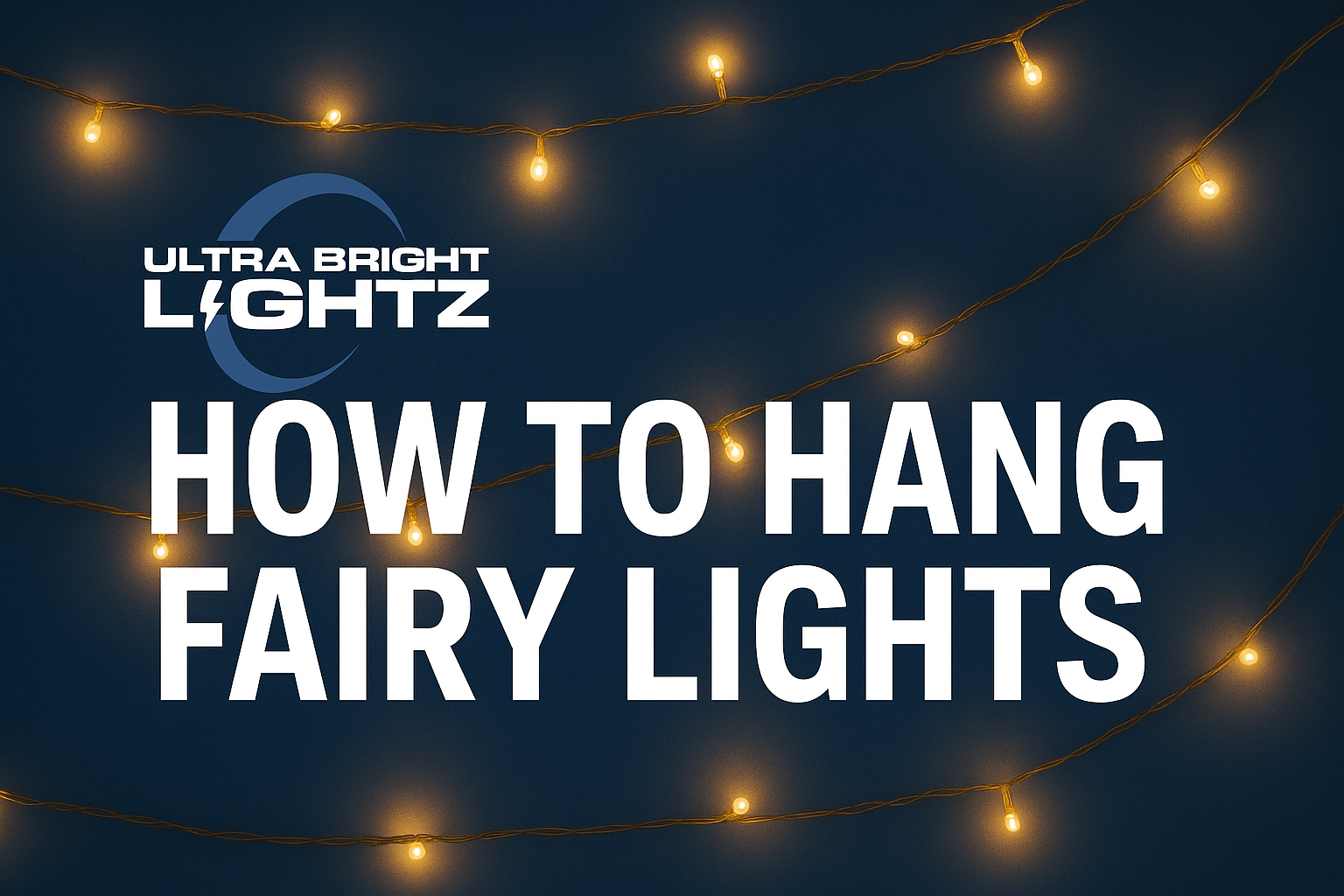Transforming your space with fairy lights' warm, inviting glow can create a magical atmosphere perfect for relaxation or entertaining. But faced with a tangled bundle of lights and bare walls, you might wonder: how do you properly hang fairy lights?
The basic process involves installing hooks or adhesive clips every 2-3 feet along your desired path. Then, carefully string the lights between these points, ensuring the wire remains taut but not stretched while always following safety guidelines for electrical connections.
While this simple approach works for basic installations, there's much more to consider depending on your space, wall materials, and the lighting effect you want. That’s why we’re here to break down expert techniques for different surfaces, creative pattern ideas, and essential safety tips that will help you create the perfect fairy light display without damaging your walls or lights.
Different Types Of Surfaces And How To Hang Fairy Lights On Them
1. Drywall & Plaster
For these common interior wall types, your best options include:
-
Adhesive Hooks or Command Strips: These leave no residue when properly removed and can hold light to medium-weight strands.
-
Push Pins or Thumbtacks: For lightweight strands where tiny holes aren't a concern.
-
Mounting Putty: Useful for temporary installations that won't drag down your light strand.
Pro Tip: Place hooks slightly above eye level to create the most flattering ambient lighting while keeping wires out of direct view.
2. Brick, Concrete & Stone
These tougher surfaces require specialized approaches:
-
Brick Clips: These slip directly onto bricks without tools or damage.
-
Screw-in Hooks with Anchors: For permanent installations where drilling is permitted.
-
Strong Adhesive Hooks: Look for versions specifically rated for rough or textured surfaces.
3. Wood
Wooden surfaces offer several straightforward options:
-
Cup Hooks: These screw in easily and provide a secure anchor point.
-
Staple Gun: Use with caution and only on wood where small holes are acceptable.
-
Removable Hooks: For temporary setups where you want to avoid permanent damage.
4. Glass & Tile
For these smooth, non-porous surfaces:
-
Suction Cup Hooks: Ideal for windows and other glass surfaces.
-
Gel Cling Hooks: These adhere well to smooth surfaces without adhesives.
-
High-Quality Clear Adhesive Hooks: Look for those specifically designed for bathroom or kitchen use.
Safety Note: ALWAYS ensure hooks and mounting hardware can support the weight of your light strands, especially when using multiple connected sets.
Creating Different Lighting Patterns And Effects
The way you arrange your fairy lights can dramatically transform your space:
-
Curtain Effect
-
Hang strands vertically from a horizontal wire or rod.
-
Creates a dramatic wall of light perfect for backdrops or room dividers.
-
Works best with denser light strands or multiple strands placed close together.
-
Canopy or Ceiling Display
-
Attach multiple strands to a central point on the ceiling.
-
Spread outward to various points on the walls or ceiling corners.
-
Creates a starry-night effect that draws the eye upward.
-
Zig-Zag Pattern
-
Install hooks in alternating high and low positions across a wall.
-
Weave lights back and forth between these points.
-
Efficiently covers larger wall spaces with fewer lights.
-
Framing Features
-
Outline windows, doorways, headboards, or architectural features.
-
Creates definition and highlights existing elements in your space.
-
Try using the lights with painters' tape for precise temporary outlines.
For a more subtle and diffused glow, consider these techniques:
-
Behind Sheer Fabrics: Drape lights behind translucent curtains or canopy beds.
-
Inside Frosted Glass Containers: Place battery-operated strands in jars or vases.
-
Mixed with Greenery: Weave lights through artificial plants or around natural foliage for a garden-inspired look.
Outdoor Installation And Weather Considerations
Outdoor fairy light installations require additional planning:
1. Weather-Resistant Equipment
-
Outdoor-Rated Lights: Always use lights specifically labeled for exterior use.
-
Weatherproof Connections: Ensure all plugs and connection points are protected from moisture.
-
GFCI Outlets: Connect to ground fault circuit interrupter outlets for safety.
2. Secure Installation Methods
-
Guide Wires: For longer spans, install a thin wire or cable first, then attach lights to prevent sagging.
-
UV-Resistant Zip Ties: These last longer than regular plastic ties in sun exposure.
-
Outdoor-Specific Clips: Look for versions designed to withstand temperature fluctuations.
3. Strategic Placement
-
Under Eaves: Install under covered areas when possible to extend lifespan.
-
Allow for Movement: Leave some slack in strands to prevent tension from wind.
-
Elevated Connections: Keep plugs and power sources off the ground to prevent water exposure.
Winter Tip: In colder climates, install lights before temperatures drop too low, as the wires become less flexible and more prone to cracking in freezing weather.
Safety And Power Management For Fairy Lights
Safety should always be your top priority when working with electrical lighting:
1. Pre-Installation Checks
-
Inspect All Strands: Look for frayed wires, broken bulbs, or damaged plugs.
-
Check Ratings: Verify that your lights match your intended use (indoor/outdoor).
-
Read Manufacturer Guidelines: Note the maximum number of connected strands (typically 3-5).
2. Power Solutions
-
Timers: Use a timer to control when lights turn on and off automatically.
-
Smart Plugs: These allow scheduling and remote control via smartphone.
-
Extension Cords: Ensure any extension cords are rated for your application.
3. Ongoing Safety
-
Heat Management: Keep fabric and paper decorations away from lights, even LED versions.
-
Regular Inspections: Periodically check for damage, especially in high-traffic areas.
-
Turn Off When Unattended: Never leave lights on when sleeping or away from home for extended periods.
Maintaining And Storing Fairy Lights
Proper maintenance extends the life of your fairy lights and prevents frustration:
1. Storage Techniques
-
Cardboard Method: Wrap lights around a piece of cardboard with notches on the sides.
-
Storage Reels: Dedicated light storage devices prevent tangling.
-
Figure-Eight Technique: Loop lights around your hand and elbow in a figure-eight pattern before securing.
2. Damage Prevention
-
Label Connections: Mark the first and last ends of longer strands.
-
Moisture Control: Store with silica gel packets in dry locations.
-
Battery Removal: For battery-operated lights, always remove batteries before storage.
3. Seasonal Care
-
Pre-Season Testing: Test all lights before installation.
-
Bulb Replacement: Replace any burned-out bulbs immediately to prevent strain on other bulbs.
-
Gentle Handling: Avoid pulling lights by the wires when installing or removing.
Editor’s Note: This is an AI image of our Founder and CEO, Justin Tomney. It looks enough like him (though, you can click here to decide for yourself). As far as we know, Justin does not regularly have contact with fairies (and none were harmed in the making of this photo).
Time To Light Up Your Space
Now that you understand how to safely and effectively hang fairy lights on various surfaces, you can transform your home with their magical glow. Start with a simple project like decorating your bedroom wall or outdoor patio, then experiment with different patterns and arrangements as your confidence grows.
The versatility of fairy lights makes them perfect for everything from everyday ambient lighting to special occasions and holiday decorating. With the proper installation techniques, your fairy lights will create a warm, inviting atmosphere while staying securely in place for as long as you need them.
FAQs
How do I hang fairy lights without damaging walls?
To hang fairy lights without damaging the wall, use removable adhesive hooks, mounting putty, or tension rods. Command strips and hooks are especially popular because they hold securely but remove cleanly. Consider over-the-door hooks or freestanding structures instead of wall mounting for heavier light strands.
What's the best way to hang fairy lights outdoors?
For outdoor fairy light installation, use guide wires or cables for long spans, outdoor-rated clips or hooks for mounting, and weatherproof connections for all power sources. Always use lights explicitly labeled for outdoor use, and install them under eaves or covered areas when possible for protection.
How many fairy light strands can I connect together?
Most standard fairy lights should not be connected more than 3-5 strands in series, as the manufacturer specifies. Exceeding this limit can cause overheating or electrical hazards. Use multiple separate power sources for larger installations or consider professional-grade lighting with higher capacity.
Should I use battery or plug-in fairy lights?
Battery-operated fairy lights are better for temporary displays, areas without outlets, or where cords would be visible. Plug-in lights are more suitable for permanent installations, longer operational times, and larger displays. Many battery-operated options now include timers and remote controls for convenience.
How do I keep fairy lights from tangling during storage?
Wind lights around a storage reel or piece of cardboard, or use the figure-eight technique. Secure ends with twist ties or Velcro straps and store in labeled boxes or bags. Taking time during removal and storage prevents frustrating tangles when you're ready to use them again.
Can I leave fairy lights on all night?
It's not recommended to leave fairy lights on overnight. Even though LED fairy lights generate less heat than traditional bulbs, leaving them unattended for long periods increases fire risk. Use timers or smart plugs to turn lights off at predetermined times for safety automatically.


